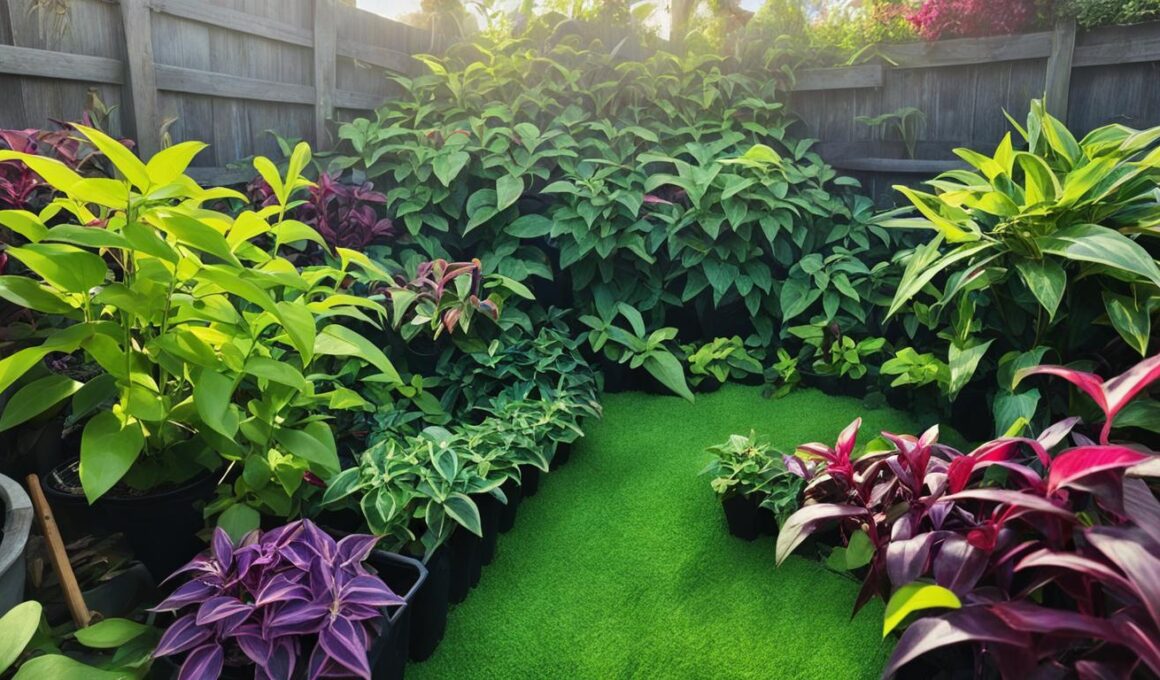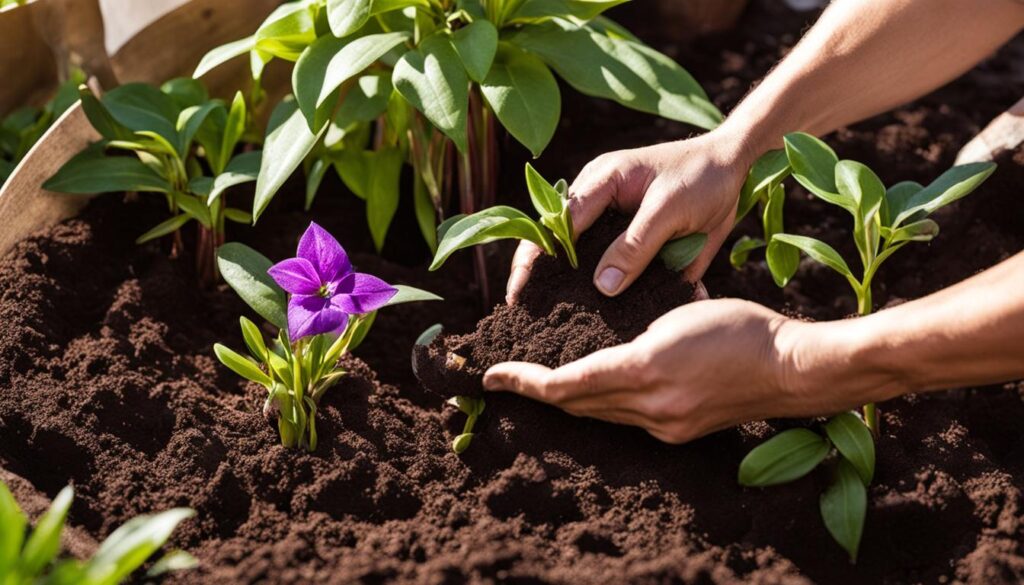If you’re looking to add a touch of vibrant greenery to your outdoor space, consider growing the Wandering Jew plant outdoors. With proper care and attention, this beautiful plant can thrive in your garden or patio, adding a pop of color and texture to your surroundings.
Wandering Jew plants prefer warmer climates and thrive in temperatures between 50-80 degrees Fahrenheit. While they can withstand some colder temperatures, it’s essential to provide protection during winter when temperatures drop below 45 degrees Fahrenheit. A cold frame or woven cloth can help shield the plant from harm.
In hot weather, when temperatures exceed 90 degrees Fahrenheit, the Wandering Jew plant will require more frequent watering and some shade during the hottest part of the day. It’s important to find a spot in your outdoor space that stays between 50-80 degrees Fahrenheit most of the year and provides a bright, partially shaded environment for the plant to thrive.
By following these care tips and providing the ideal conditions, you can create a thriving outdoor haven for your Wandering Jew plant.
Best Practices for Planting Wandering Jew Outdoors
When it comes to planting Wandering Jew outdoors, there are a few best practices to keep in mind. Whether you choose to use mobile containers or plant directly in the ground, these tips will help ensure your Wandering Jew thrives in its outdoor environment.
Mobile Containers or Planting in the Ground
When deciding how to plant your Wandering Jew outdoors, consider your climate and the flexibility you desire. In areas with cold winter temperatures, mobile containers are a great option. These containers allow you to easily move your plant indoors during winter, protecting it from frost damage. On the other hand, if you live in USDA growing zones 9-11 where temperatures rarely drop below freezing, you can plant your Wandering Jew directly in the ground.
Choosing the Right Spot
Regardless of the planting method you choose, it’s important to find the right spot for your Wandering Jew. This plant prefers partial shade during the day to prevent leaf bleaching and sunburn. Look for a location that provides a bright, partially-shaded environment for your Wandering Jew to thrive.
Moisture Matters
Moist soil is key to the success of your Wandering Jew plant. If you’re planting directly in the ground, consider using mulch to help retain moisture in the soil. For potted plants, choose a potting soil that retains moisture well. This will help ensure that your Wandering Jew gets the hydration it needs to flourish in its outdoor setting.
Hanging Containers with Coco Coir Liners
If you prefer a hanging container for your Wandering Jew, opt for one with coco coir liners. These liners allow for increased airflow, which is beneficial for the plant. However, be aware that hanging containers tend to dry out more quickly, so frequent watering will be necessary to keep your Wandering Jew properly hydrated.
Tips for Maintaining Wandering Jew Plant Outdoors
When it comes to caring for your Wandering Jew plant outdoors, there are several important considerations to keep in mind. By following these tips for Wandering Jew care, pruning, and protecting from animals, you can ensure that your plant thrives in its outdoor environment.
Regular Pruning
Wandering Jew plants are known for their vigorous growth and tendency to spread rapidly. To maintain their size and appearance, regular pruning is essential. Trimming the plant at a stem joint can even provide new plants – simply place the cut stems in water, and roots should grow within a couple of weeks.
Protecting from Animals
Animals such as dogs, cats, ferals, and deer may be attracted to the foliage of Wandering Jew plants, posing a threat to their well-being. It’s important to consider the presence of these animals and take measures to protect the plant. Wandering Jew plants can cause dermatitis-like reactions in most dogs, cats, livestock, and wildlife, so it’s advisable to keep the plants out of their reach.
Maintaining Humidity
Wandering Jew plants thrive in humid environments. Regular misting of the leaves and ensuring the soil remains damp can help maintain the humidity levels that these plants prefer. This will contribute to their overall health and vigor.
To summarize, proper Wandering Jew care involves regular pruning to control growth, protecting the plant from animals, and maintaining the desired humidity levels. By following these tips, you can enjoy a thriving and beautiful Wandering Jew plant in your outdoor space.
Conclusion
In conclusion, growing Wandering Jew plants outdoors can be a rewarding experience with the right care and attention. These plants thrive in temperatures between 50-80 degrees Fahrenheit, so it’s important to provide them with a suitable environment. During winter, protection like a cold frame or woven cloth is necessary to shield the plant from temperatures below 45 degrees Fahrenheit. And in hotter weather, extra watering and shade during the hottest part of the day are crucial.
When it comes to planting Wandering Jew outdoors, you have a choice between mobile containers and planting in the ground. Mobile containers are ideal for areas with cold winters, allowing you to bring the plant indoors when necessary. In USDA growing zones 9-11, where freezing temperatures are rare, planting directly in the ground is an option. Remember to choose a spot with partial shade to protect the leaves from bleaching and sunburn and ensure moist soil through proper mulching or potting soil.
Maintaining Wandering Jew plants outdoors requires regular pruning to control their growth and appearance. The pruned stems can even be propagated into new plants. Additionally, it’s important to consider the presence of animals that may attempt to nibble on the foliage. These plants can cause dermatitis-like reactions in animals, so keep them out of reach. Finally, maintaining humidity through misting the leaves and damp soil is essential for the well-being of Wandering Jew plants.
Can I Use Peat Moss to Help Grow the Wandering Jew Plant Outdoors?
Yes, you can use peat moss to help grow the Wandering Jew plant outdoors. Mixing peat moss into the soil can improve moisture retention and provide essential nutrients for the plant’s growth. Follow these top lawn tips for peat moss to ensure your Wandering Jew thrives in an outdoor environment.










